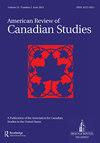书籍和图书馆:对知识和文化的探索。Marcel Lajeunesse提供的混合物
IF 0.4
Q3 AREA STUDIES
引用次数: 0
摘要
在这种情况下,数据是一种生产非公民身份的技术形式。以历史档案的形式来看,这些数据是一种令人难以置信的资源,但也有助于突显个人数据和国家批准的大规模抓捕的其他特征如何在今天继续被使用,比如针对中国的维吾尔族少数民族。c9s还揭示了之前的研究人员对加拿大华人移民社区的了解:几乎所有的照片都是男性。但也有例外,正是这些故事的揭露吸引了这位读者。赵显娥详细列举了白人妇女、白人妇女和儿童、中国妇女和儿童、单独儿童的照片,并通过一个试图阻止这种关系的政权,展示了家庭和亲属关系的复杂性。事实上,嫁给中国男人的白人女性进入了一种法律上的不确定状态,她们可以以公民身份投票,但也必须与标记为中国人的家人一起旅行。他们的儿子和女儿被认为是中国人,因此这些亲属关系不会产生公民,这是国家强制非公民的另一种方式。《大规模捕获》的人性让我很感动。当她试图在这个丰富的档案中插入代理和抵抗的迹象时,赵以如此的激情写作。对我这个读者来说,将无数迄今未知的移民的形象赋予生命是一种非常有益的经历,尤其是考虑到国家强烈希望限制他们与加拿大的联系。此外,赵社长和同事们还制作了网站,提高了该书的观赏性。发现于masscapture。在这里,读者可以仔细看看赵和她的团队通过耗时而精细的摄影过程精心制作的众多CI 9。对于Cho来说,仅仅看缩微胶卷是不够的,她选择通过将它们逐一数字化,使它们的细微差别栩栩如生,结果是图像更加清晰,使研究人员能够专注于对污迹、划痕和签名等细节进行视觉分析。对研究人员来说,大规模捕获是一个巨大的资源。Cho提供了一种非常有启发性的方式,从以前被忽视的材料中揭示历史。她为无声者发声,这本身就是一种人道和反抗的行为。本文章由计算机程序翻译,如有差异,请以英文原文为准。
Le livre et la bibliothèque: La quête des savoirs et de la culture. Mélanges offerts à Marcel Lajeunesse
data in this case was a form of technology for the production of non-citizenship. Such data is an incredible resource in the form of a historical archive, but also serves to highlight how personal data and other features of the state sanctioned mass capture continues to be used today, such as toward the Uighur minority in China. The CI 9s also reveal what previous researchers know already about the Chinese migrant community in Canada: almost all the photos were of men. But there are exceptions, and it is the uncovering of these stories that captivated this reader. Cho details examples of photographs of white women, of white women and children, of Chinese women and children, of children alone, and demonstrates the complicated nature of family and kinship ties via a regime that sought to deter such relationships. Indeed, white women who married Chinese men entered a legal limbo in which they could vote as citizens but who also had to travel with their families, marked as Chinese. Their sons and daughters were considered Chinese and thus these kinship ties did not produce citizens, yet another way the state enforced non-citizenry. There is a humanity to Mass Capture that I found quite moving. Cho writes with such passion as she attempts to interject agency and signs of resistance in this rich archive. The very idea of bringing life to the images of countless heretofore unknown migrants was a deeply rewarding experience for this reader especially considering the firm desire of the state to limit their connection to Canada. The humanity also extends to the fact that Cho and her associates created a website to enhance the experience of the book. Found at masscapture.ca, readers can take a closer look at numerous CI 9s that Cho and her team painstakingly reinvigorated via a time-consuming and delicate photography process. It wasn’t enough for Cho to look at microfilm, she opted to bring to life their nuances by digitizing them again, certificate by certificate, with the result being much crisper images that allow the researcher to focus on the visual analysis of such details as smudges, scratches, and signatures. Mass Capture is a tremendous resource for researchers. Cho offers a very revealing way to uncover histories from materials previously neglected. She gives voice to the voiceless, an act of humanity and resistance in its own right.
求助全文
通过发布文献求助,成功后即可免费获取论文全文。
去求助
来源期刊

American Review of Canadian Studies
AREA STUDIES-
CiteScore
0.60
自引率
0.00%
发文量
25
期刊介绍:
American Nineteenth Century History is a peer-reviewed, transatlantic journal devoted to the history of the United States during the long nineteenth century. It welcomes contributions on themes and topics relating to America in this period: slavery, race and ethnicity, the Civil War and Reconstruction, military history, American nationalism, urban history, immigration and ethnicity, western history, the history of women, gender studies, African Americans and Native Americans, cultural studies and comparative pieces. In addition to articles based on original research, historiographical pieces, reassessments of historical controversies, and reappraisals of prominent events or individuals are welcome. Special issues devoted to a particular theme or topic will also be considered.
 求助内容:
求助内容: 应助结果提醒方式:
应助结果提醒方式:


